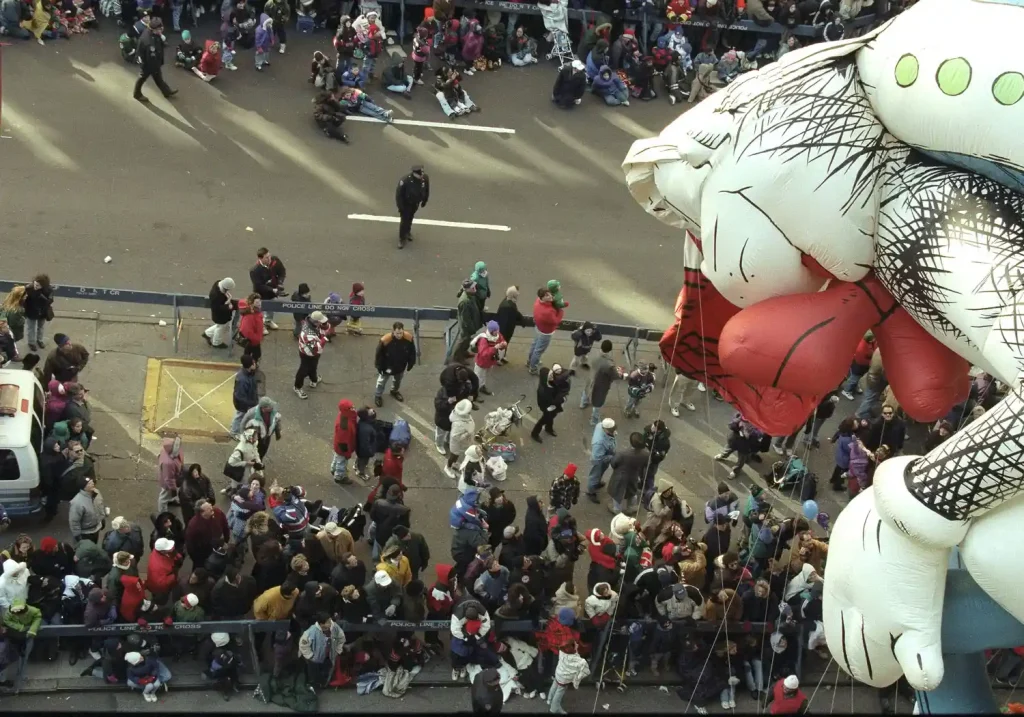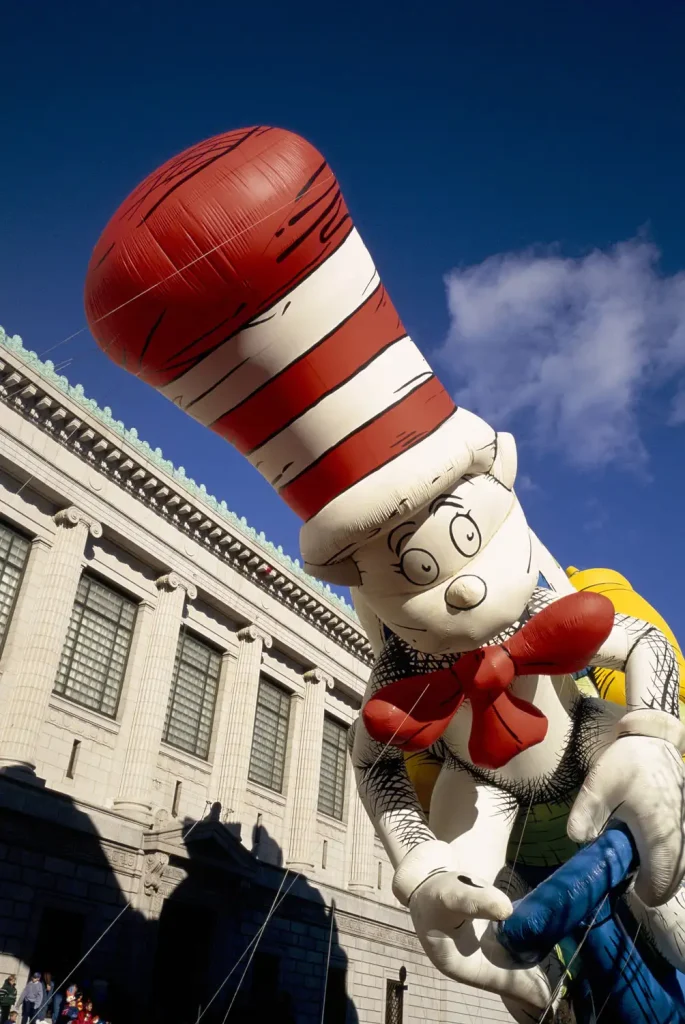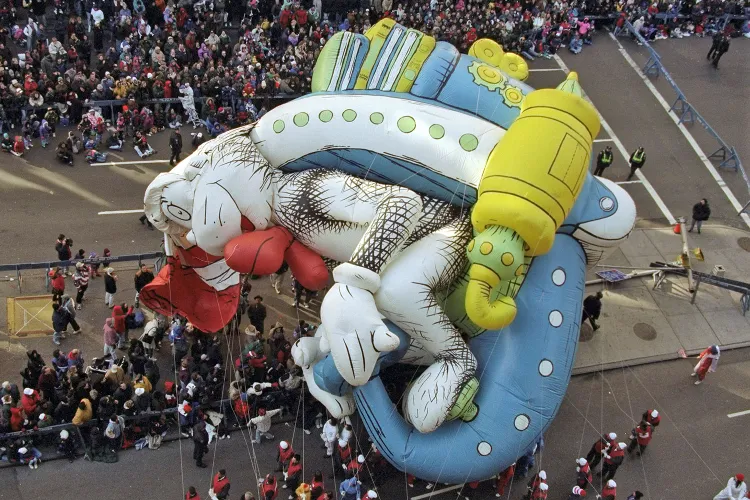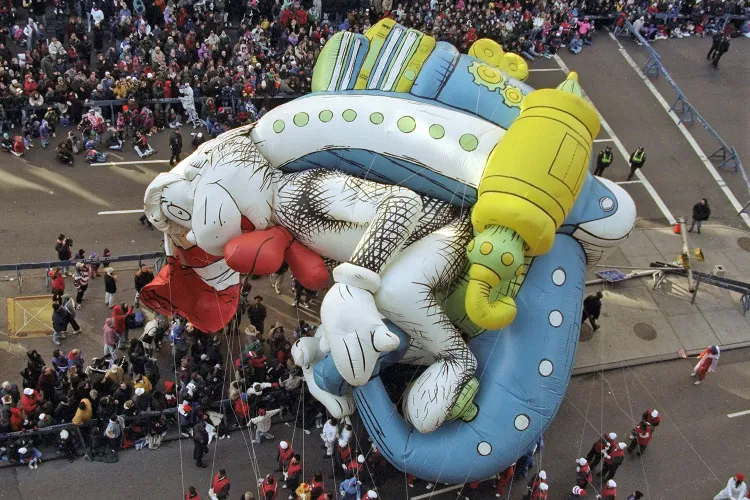How the Cat in the Hat Balloon Nearly Killed a Woman at the 1997 Macy’s Thanksgiving Day Parade — Inside the Terrifying Accident That Changed Parade Safety Forever
For most Americans, the Macy’s Thanksgiving Day Parade is a symbol of holiday warmth — a spectacle of bright colors, soaring balloons, festive music, and familiar characters drifting peacefully through Manhattan’s brisk late-November sky. Families gather around televisions, children press against barricades, and the entire event hums with excitement and nostalgia. But on Thanksgiving Day in 1997, the parade became the center of a frightening, nearly fatal accident that would haunt the city for years. At the heart of it was Kathleen Caronna, a New York resident who simply wanted to spend the holiday morning watching the beloved tradition with her family. What she experienced instead would change her life, reshape parade safety standards, and serve as a sobering reminder of just how unpredictable live events can be.

The crowd that Thursday morning was enormous, even by New York standards. The air was cold, the sky clean, and anticipation crackled through the streets as the balloons began making their way down the parade route. Spectators bundled in hats and scarves craned their necks to catch glimpses of their favorite characters. Among them was the Cat in the Hat — a massive, newly designed balloon added to the parade lineup only a few years earlier. At an estimated 78 feet long and towering several stories high, the balloon had become an instant crowd favorite. Its bright red-and-white-striped hat and mischievous grin felt made for holiday television.
Kathleen Caronna was standing with her husband and young son near 72nd Street, enjoying the familiar energy of the parade. Like thousands of families, they were settled in place, ready to capture memories, and unaware of the danger moving silently toward them. Parade organizers knew that winds were a concern that year — gusts were strong enough to make balloon handlers tighten their grips — but the parade continued as usual. New York has weathered windier Thanksgivings. No one predicted that one of the parade’s most cheerful balloons would become the source of one of its darkest moments.

As the Cat in the Hat balloon approached the intersection, handlers struggled against a sudden, forceful wind gust. The balloon tilted sharply, its enormous surface acting like a sail. A chaotic ripple of tension ran down the ropes. The handlers — dozens of volunteers trained for moments like this — tried desperately to keep the balloon steady. But with a balloon of that size, a single wrong angle can overpower even the most coordinated team. Witnesses later recalled seeing the balloon sway dangerously, almost as if it were losing its sense of direction. It drifted toward a streetlight pole, the vast fabric catching against the metal arm.
In the span of seconds, the situation shifted from concerning to catastrophic. The balloon clipped the pole with enormous force, snapping the large arm off its base. The heavy metal arm fell, spinning downward toward the crowd. There was no warning, no chance to scatter, no time for anyone to react. The metal crashed into the spectators below, striking multiple people — but it was Kathleen Caronna who suffered the gravest blow. She was hit directly in the head, collapsing instantly.

The crowd’s festive cheering turned to horrified screams. Parade volunteers rushed in, police officers sprinted toward the scene, and the Cat in the Hat balloon deflated clumsily across the street as handlers cut their ropes to prevent further danger. The parade kept moving — a difficult decision designed to prevent panic — but the stretch of roadway where the accident happened no longer felt like a place of celebration. It felt like an emergency zone.
Kathleen was rushed to the hospital in critical condition. Reports at the time confirmed she slipped into a coma, and the family remained by her side as doctors worked to stabilize her. Her injuries were severe, including skull fractures and long-term neurological complications. For many New Yorkers, it was the first time the beloved parade had ever been associated with real fear.
The accident sent shockwaves through the city. It became national news within hours. The idea that a holiday parade — one designed for children — could nearly turn deadly was unthinkable. Officials immediately began investigating what had gone wrong. Weather conditions had been marginal, but not alarmingly abnormal. The issue wasn’t just the wind — it was the sheer size of the balloons. That realization led to some of the most significant safety reforms in Macy’s parade history.

Over the following year, city officials, safety engineers, and parade organizers worked together to create stricter rules for balloon size, wind thresholds, and emergency procedures. For the first time, balloons were required to meet new height and size limits. The city implemented guidelines specifying the maximum allowable wind speeds for different balloon categories. If winds exceeded those limits, large balloons would be grounded entirely. These rules remain in place today, and they are directly tied to the trauma Kathleen experienced.
As the investigation continued, the Caronna family faced the long road of medical recovery. Kathleen eventually awakened from her coma, but the damage was life-altering. Her injuries required ongoing care, and the emotional scars proved equally long-lasting. The parade — once a cherished family tradition — had become the day her life split into “before” and “after.” She later filed a lawsuit against the city, Macy’s, and the companies responsible for the pole and parade logistics. The case eventually reached a multimillion-dollar settlement, a formal acknowledgment of the harm she endured.

But even as her personal life reshaped itself around recovery, the city’s memory of the accident lingered. Parents began watching the parade with new caution. The sight of a balloon passing too close to a building edge or leaning into the wind made viewers uneasy. Parade organizers worked tirelessly to restore public trust, and over time, the event regained its sense of safety — but the story of 1997 was never forgotten.
What makes the incident so haunting is how ordinary it began. Caronna was simply watching a parade — one she had enjoyed for years — alongside her husband and child. She wasn’t in harm’s way. She wasn’t standing somewhere unsafe. She was doing what millions of people do every Thanksgiving: taking in a beloved tradition. But the intersection of wind, scale, and circumstance created a scenario no one could have predicted in time.
In the decades since, those who remember the accident often speak about it with a mixture of sorrow and gratitude — sorrow for what Kathleen endured, and gratitude that the tragedy sparked reforms that have almost certainly saved lives. The Cat in the Hat balloon was immediately retired from the parade. It became a symbol not of holiday cheer, but of how quickly joy can turn to danger when precautions aren’t strong enough.
Today, viewers still gather along Central Park West and Sixth Avenue, still cheer as Snoopy, Pikachu, and other giants float into view, still treat the parade as a marker of the holiday season. But the safety standards guiding those balloons are far more robust than they were in the 1990s. Every year, city officials meet with parade organizers before the event, analyzing wind forecasts, approving balloon flight decisions, and, if needed, ordering balloons to be lowered or removed. It’s an unseen layer of vigilance built directly from the lessons learned in 1997.
For Kathleen Caronna, the years after the accident brought another shocking twist. In 2006, nearly a decade after her parade injury, a small plane crashed into her apartment building — the plane piloted by New York Yankees pitcher Cory Lidle. Miraculously, Kathleen survived yet again. The coincidence made headlines across the country, leading many to call her “the unluckiest lucky woman in New York.” It was a strange, unsettling echo of the fragility of circumstance — a reminder that life rarely follows rules of fairness.
But despite everything she endured, the 1997 parade accident stands as a pivotal moment not because of its tragedy, but because of its lasting impact. It forced the country to confront the hidden complexities of a beloved tradition. It revealed the risks behind the smiles of the balloon handlers, the engineering behind the spectacle, and the delicate balance required to make a massive event feel effortless.
Today, when families settle in to watch the parade, whether bundled on the sidewalks or cozy at home, most never think about the changes written into its safety DNA. Most don’t know that a woman’s life changed the course of parade history. But the truth remains quietly embedded behind every soaring character: the Macy’s Thanksgiving Day Parade is safer because of the accident Kathleen Caronna survived. Her story is painful, heartbreaking, and unforgettable — and it ensured that future generations could enjoy the parade with the sense of wonder it was always meant to inspire.



